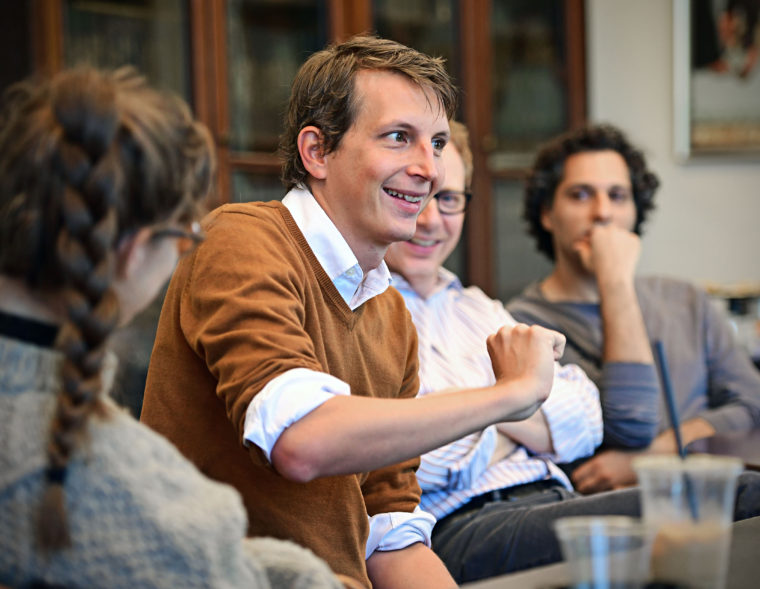At 17, Garth Risk Hallberg took Greyhound from his small town in North Carolina to New York City. The trip was long and dull. But then, somewhere on the New Jersey Turnpike, he got his first glimpse of the Twin Towers.
“My soul leaped up,” says Hallberg, who graduated with a degree in English literature from Arts & Sciences in 2001. “It was like the city was saying, ‘You made it!’”
Hallberg is the author of the acclaimed bestseller City on Fire and a fierce champion of the American city, especially its biggest one — New York. He loves the crowds and the culture, the communities and the chaos.
“As a kid I had three escapes: music, books and cities,” Hallberg says. “Cities can be a place of loneliness, alienation and estrangement, but they also are a place of connection.”
Hallberg always planned to move to New York after college. Alas, his girlfriend, Elise White, who graduated in 2000 also with a degree in English and another in African- American studies, had enrolled in a doctoral program at University of Maryland. The couple, now married with two children, met at a Dauten Hall kegger and didn’t want to be apart.
“The city could wait, but the girl probably could not, so I followed her,” Hallberg says.
The couple settled in Washington, D.C., another city Hallberg knew well. In high school, Hallberg would go there to see hardcore bands. Back home, he felt like a misfit, but in the mosh pits of D.C.’s punk clubs, Hallberg belonged. Now he was back, and life was good.
Until 9/11.
Hallberg remembers wondering how many planes would strike and where. Then, in the weeks that followed, he was haunted by a new question: Would the city wait after all?
“Something was happening in New York that I felt I had to make contact with and bear witness to,” says Hallberg, who once again started taking the bus to New York. “There was this feeling of camaraderie in the bars and streets. It wasn’t happy-go-lucky: ‘Let’s join hands and sing.’ It was people really recognizing each other as humans who have been through the same loss. There was an amazing awakening.”
On one trip, this time to find an apartment, Hallberg raised his eyes on the Turnpike to see what was no longer there. At that moment, the Billy Joel song “Miami 2017” started to play on his iPod. The prescient track, released a year before the New York blackout of 1977, imagines a dystopian New York seized by blackouts and riots.
“He sings with a sort of yearning; that even though New York was a hell hole, there was a possibility there that doesn’t exist in the cleaner and more orderly world of Miami in 2017,” Hallberg says. “I thought to myself, ‘That’s a book.’ Then I thought, that’s the book. By the end of the song, I had a vision for a Bleak House with a punk-rock soundtrack.”
That vision became City on Fire, now in paperback. The book could be called a suspenseful whodunit about Sam — daughter of a fireworks manufacturer, girlfriend of an anarchist and mistress of a connected businessman — who is shot in Central Park on New Year’s Eve in 1976. More accurately, City on Fire is an epic tour de force that explores the people, places and ideas that shaped America’s greatest city. The book goes deep on punk rock, real estate development, drugs, journalism, fine art and race relations, and it ends the morning after the blackout.
“You know something is going to change because it can’t be like it was anymore,” Hallberg says. “That was true in 1977 and that was true in 2001.”
The book generated a ton of headlines: Some for the whopping $2 million fee publisher Albert A. Knopf paid Hallberg, and others for the volume’s sheer size of 911 pages. But many were for Hallberg’s talent as a storyteller. Michiko Kakutani of The New York Times called City on Fire, “a novel of head-snapping ambition and heart-stopping power — a novel that attests to its young author’s boundless and unflagging talents.” And Ron Charles wrote in the Washington Post, “Dazzling. … Endlessly fascinating. … A novel whose Whitmanesque arms embrace an entire city of lovers and strivers, saints and killers. … City on Fire is an extraordinary performance.”
Looking back, Hallberg admits he was both daunted by the book’s scope and fearful that readers would consider its length an act of insanity. That explains the four-year gap between that bus trip and the day he sat down to write.
“I ran in fear of it,” Hallberg says. “It was so big and so sprawling, and I was a nobody. It just seemed like a really odd thing to be doing. But then I decided, ‘No more playing it safe. I should be working on the thing that scares me the most.’ I still believe that today.”
Diane Toroian Keaggy, AB ’90, is senior news director of campus life at the university.
